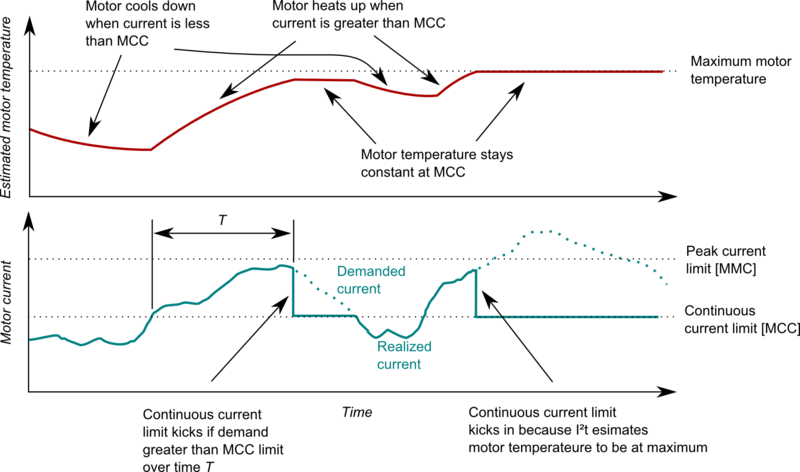Difference between revisions of "I²t protection"
| [checked revision] | [checked revision] |
| (3 intermediate revisions by 2 users not shown) | |||
| Line 5: | Line 5: | ||
I²t protection continuously estimates how much motor is dissipating heat compared to its rated heat dissipation. At 100% of rated current, heat dissipation is at maximum sustainable level. Care need to be taken only when driving more current than rated current. | I²t protection continuously estimates how much motor is dissipating heat compared to its rated heat dissipation. At 100% of rated current, heat dissipation is at maximum sustainable level. Care need to be taken only when driving more current than rated current. | ||
| − | I²t algorithm will simply limit output current to rated current level if algorithm calculates that motor temperature is already at maximum. If calculated temperature is below maximum, then higher (peak) currents are allowed. | + | I²t algorithm will simply limit output current to rated current level if algorithm calculates that motor temperature is already at maximum. If calculated temperature is below maximum, then higher (peak) currents are allowed. In other words: |
| + | * Current/torque setpoint is internally clamped to a user defined {{Param|MMC}} if I²t calculation shows temperature rise to be less than motor's maximum safe level | ||
| + | * Current/torque setpoint is internally clamped to a user defined {{Param|MCC}} if I²t calculation shows temperature rise to be equal or grater than motor's maximum safe level | ||
| + | |||
| + | [[File:Currentlimits graph i2t.png|800px]] | ||
| + | |||
==Parameters== | ==Parameters== | ||
| − | When configuring I²t protection, only one [[GDtool]] parameter needs to be set: | + | [[File:i2t.JPG|thumb|Granity will display the actual current limitation reason in the Testing tab. In this example the limit reason is I²t protection, so drive has dropped Actual current limit to the value of MCC parameter.]]When configuring I²t protection, only one [[GDtool]] parameter needs to be set: |
;Motor time constant | ;Motor time constant | ||
:Time in seconds how long it takes motor temperature rise to 63% from idle temperature to maximum allowed temperature when motor is driven continuously with 100% of rated current. If unsure, use low values (<500 seconds) to have error in safe direction. | :Time in seconds how long it takes motor temperature rise to 63% from idle temperature to maximum allowed temperature when motor is driven continuously with 100% of rated current. If unsure, use low values (<500 seconds) to have error in safe direction. | ||
==See also== | ==See also== | ||
| + | *[[Motor peak and continuous current limits]] | ||
*[http://www.copleycontrols.com/motion/pdf/IsqT.pdf Copley Controls explanation of I²t method] | *[http://www.copleycontrols.com/motion/pdf/IsqT.pdf Copley Controls explanation of I²t method] | ||
| + | |||
| + | [[Category:Glossary]] | ||
[[Category:Technology]] | [[Category:Technology]] | ||
Latest revision as of 22:51, 19 October 2017
I²t protection is a motor overload protection method based on motor thermal modeling. I²t is a kind of sensorless motor over temperature protection.
Protection mechanism[edit | edit source]
Motor heat generation is typically dominated by resistive heat dissipation. The heat dissipation of resistance is proportional to flowing current in power of two. I²t algorithm assumes resistive dissipation being the only heat source of motor which is good enough estimate to prevent motor burning.
I²t protection continuously estimates how much motor is dissipating heat compared to its rated heat dissipation. At 100% of rated current, heat dissipation is at maximum sustainable level. Care need to be taken only when driving more current than rated current.
I²t algorithm will simply limit output current to rated current level if algorithm calculates that motor temperature is already at maximum. If calculated temperature is below maximum, then higher (peak) currents are allowed. In other words:
- Current/torque setpoint is internally clamped to a user defined Peak current limitMMC if I²t calculation shows temperature rise to be less than motor's maximum safe level
- Current/torque setpoint is internally clamped to a user defined Continuous current limitMCC if I²t calculation shows temperature rise to be equal or grater than motor's maximum safe level
Parameters[edit | edit source]
- Motor time constant
- Time in seconds how long it takes motor temperature rise to 63% from idle temperature to maximum allowed temperature when motor is driven continuously with 100% of rated current. If unsure, use low values (<500 seconds) to have error in safe direction.

